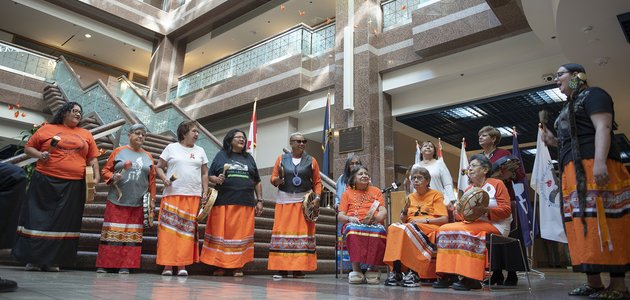An installation of paper cranes symbolizing residential school victims and survivors was unveiled at police headquarters on September 23.
Handmade by members of the Indigenous community, it is titled Debwewin, which is the Ojibway word for truth.
One of seven original Clans, the Crane represents wisdom and equal communication for all Anishinaabe.
“This project will serve to remind all those who enter our headquarters in the days to come of important historical truths and lived experiences that have gone ignored for far too long,” Chief James Ramer said. “The cranes symbolize the children lost and the survivors of the residential school system. But so too do they represent the leadership and wisdom of the Indigenous community, the voices that, as a policing community, we must continue and learn from. In this, we have a long way to go.”
Ramer vowed that the Service will continue to move forward on the path of reconciliation.
“Together, we mourn the many victims of residential schools and acknowledge its profound and ongoing impacts, including generational trauma and pain,” he added. “Together, we look to the essential work done by the Truth and Reconciliation Commission and especially those ‘Calls to Action’ related to justice. Together, we recognize that more than offering words alone, we must act. And do so with purpose and conviction to address systemic racism and to build stronger bonds of trust with Indigenous peoples. All such efforts are, after all, fundamental to our core values as police officers, to treat those we serve with empathy, respect, equity and dignity.”
The event comes a week before the celebration of the National Day for Truth and Reconciliation and Orange Shirt Day on September 30.
The day honours the children who never returned home and survivors of residential school as well as their families and communities. Public commemoration of the tragic and painful history and ongoing impacts of residential schools is a vital component of the reconciliation process.
Orange Shirt Day is an Indigenous-led grassroots commemorative day intended to raise awareness of the individual, family and community inter-generational impacts of residential schools, and to promote the concept of “Every Child Matters.”
The Orange Shirt is a symbol of the stripping away of culture, freedom and self-esteem experienced by Indigenous children over generations.
“We will have the occasion to, as an entire country, commemorate the tragic history of residential schools,” noted Ramer. “Until then, we have the opportunity to make a difference, to take inspiration from this installation and the many hands that brought it to fruition. We have the opportunity to learn, to reflect and to act. I will encourage all my fellow officers and our larger policing community to continue carrying out this vital work.”
The Chief thanked everyone for bringing the project to life.
“Thank you for our dedication and service to your community and thank you all for your support this morning,” he added.
Toronto Police Services Board Chair Jim Hart urged officers and community members viewing the installation to use that time as an opportunity to learn and reflect on the meaning of truth and reconciliation.
“While we cannot change the past, we can determine the path forward,” he said. “This requires sincere reflection, deep introspection and continued dedication in a spirit of mutual respect, dialogue and honesty.”
Constable Richard Warman, the Service’s Aboriginal Liaison Officer, provided some background and reflections on the Orange Crane project.
“As the project evolved, it began to take on a life of its own,” he said. “Each crane symbolizes either a survivor or child lost as a result of the Indian Residential School system either directly or inter-generationally. The Cranes are in flight and carrying their words, their prayers and their messages to the Creator. But if you look closely, a lot of them are returning to us on the ground towards mother earth. These are the voices of lost children and survivors carrying their stories, their words and dreams — their Debwewin for us to hear.”
Frances Sanderson, the co-chair of the Service’s Aboriginal Consultative Committee, said the project is beautiful.
“It warms my heart to see this project and the all the work that has been put into it,” she said.
The Red Bear Singers from the Toronto Council Fire & Native Cultural Centre comprising Residential School survivors and inter-generational singers sang a welcome song to start the proceedings. They also performed an honour song for Toronto Police Constable Andrew Hong who was killed in the line of duty and York Regional Police Constable Travis Gillespie who died in a collision while on his way to work.






